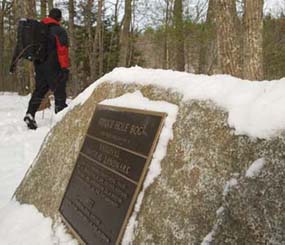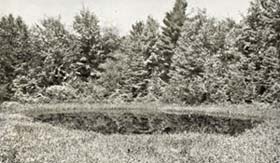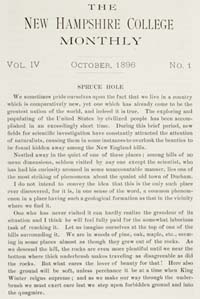 |
 |
| current issue |  | past issues |  | send a letter/news |  | address update |  | advertise |  | about us |  | alumni home |
On Ben's Farm
|
Bottomless Bog?
A Durham kettle hole is the site of an unsolved mystery By Mylinda Woodward '97 Also read the magazine print version of On Ben's Farm |
Easy to print version |
 Erin Gleason |
Almost as soon as the New Hampshire College of Agriculture and the Mechanic Arts moved to Durham in 1893, Clarence M. Weed, professor of zoology and entomology, began to explore the area. Durham, he said, was a "fortunate region for the home of a naturalist. The diversity of soil surface—shown by the barren, sandy tracts, the rocky hills, the fertile lowlands, the tide-washed wastes, the bay shores--has led to the development of an extraordinary variety of plants and animals."
One of his happy discoveries was a true kettle-hole bog within two miles of his lab in Thompson Hall. Known to the locals as "Spruce Hole," the bog, a unique geological formation created at the end of the last ice age, was known for its ancient beauty as well as the secrets it concealed.
Mary P. Thompson, a town historian and niece of the college's first benefactor, Benjamin Thompson, described the site in her 1888 publication of Landmarks of Ancient Dover and the Towns Which Have Sprung Therefrom.
"It is somewhat difficult of access, being surrounded by dense woods and almost impenetrable tickets, but is well worth the trouble of visiting. It is a remarkable bowl-like depression in the ground, and covers five or six acres. The direct depth from the level about to the bottom of the bowl must be a hundred feet. The sides are very steep, and were once lined, and still are, in part, with spruce trees, which impart a peculiar solemnity to the place. The bottom of the bowl is a quaking bog, covered with a bed of thick, soft moss, from which water oozes at every step. Here grow a variety of orchids, the sundew, the side-saddle flower, and other curious plants, and it is the haunt of multitudinous insects, whose hum on a summer's day alone breaks the solemn stillness of the solitary spot. In the centre is a dark pool, said to be unfathomable, concerning which there is a tragical legend."

LOCAL LANDMARK: Spruce Hole, shown here in a 1896 photo, is locared off a logging road on Packers Falls Road, about 750 feet west of the Mill Road intersection. |
The unique ecosystem of the bog appealed to the college professors, but for the students, its aura of mystery, created by the carnivorous plants, ground that moved underfoot, bottomless pond and tragic lore, was far more fascinating.
Miss Thompson gave no details about the "tragical legend," but the students writing for the New Hampshire College Monthly had no such compunction. In the October 1896 issue, they wrote that a former owner of Spruce Hole, a Mr. Laskey, had allegedly committed murder-suicide, first killing his young son and then taking his own life by drowning in the pond. His body was never recovered.
Perhaps that was one reason the myth of the bottomless pool persisted, despite the fact that, according to Weed, soundings taken in 1896 had succeeded in finding a hard bottom.

|
In February 1918, two students armed with 200 feet of line, a 5-pound weight, shovels, axes, measures and notebooks set out to determine the truth once and for all. The New Hampshire reported the results of their efforts: "By careful measurements the center of the surface was found and a hole chopped through twenty-five inches of ice. When the axe broke through the ice, a jet of dirty brown water was forced up to a height of two feet [and] a strong odor of hydrogen sulfate permeated the atmosphere. The line and weight were made ready and when all was clear the iron was started on its descent into the traditional bottomless pit. The line played out rapidly. Foot after foot was reeled off. Still the line disappeared into the depths below. Then the pull on the cord ceased abruptly. The watchers glanced hurriedly at the remaining line, and after vain attempts to sink it farther, pulled it in and measured off the distance. The pool is twenty feet deep at the middle."
Today, tales of bottomless pits and tragic deaths are long forgotten, but appreciation of this ancient glacial landform remains strong. Ever since Clarence Weed collected his first bug there, Spruce Hole has provided a valuable natural laboratory for the university. Since 1993, research conducted at Spruce Hole has produced no less than five UNH master's theses.
Some of these projects were in connection with a larger study by the town to evaluate Spruce Hole, which is also a stratified drift aquifer, as a groundwater supply for Durham and the university.
Spruce Hole is important nationally as well. There were once six kettle holes known to exist in southern New Hampshire; all but Spruce Hole have been destroyed. In 1972, its uniqueness was recognized by the National Park Service as a National Natural Landmark. A few years later, the Durham Conservation Commission successfully negotiated ownership of the bog. On Nov. 17, 2009, the town's efforts to protect the bog from development were recognized with an official bronze plaque and a ceremony rededicating the Spruce Hole Bog National Natural Landmark. ~
blog comments powered by Disqus

